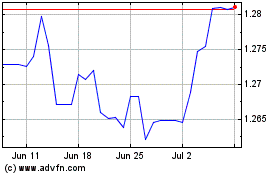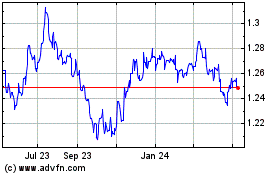U.S. Dollar Climbs Amid Risk Aversion
July 02 2018 - 4:12AM
RTTF2
The U.S. dollar strengthened against its major counterparts in
the European session on Monday amid risk aversion, as Germany faced
political crisis over immigration and trade worries persisted ahead
of a July 6 deadline when the United States is due to impose the
tariffs on Chinese exports.
While U.S. tariffs on $34 billion of Chinese products take
effect on July 6, China is expected to retaliate with duties of its
own on American goods.
Canada's retaliatory tariffs on American goods officially kicked
in Sunday in a tit-for-tat response to the Trump administration's
duties on Canadian steel and aluminum.
German political crisis also weighed, as interior minister Horst
Seehofer offered to resign both his office and his position as head
of the hardline conservative Bavarian CSU party.
Weak manufacturing data from China, Europe and the U.K. also
dampened sentiment.
The U.S. Federal Reserve is scheduled to release the minutes of
its latest monetary policy meeting this week, which may shed some
additional light on the outlook for U.S. interest rates.
The monthly U.S.jobs report along with reports on manufacturing
and service sector activity may also influence trading sentiment as
the week progresses.
The currency has been trading in a positive territory against
its major counterparts in the Asian session.
The greenback climbed to 0.9935 against the franc, from a
session's low of 0.9894 seen at 5:00 pm ET. On the upside, 1.01 is
likely seen as the next resistance level for the greenback.
The greenback spiked up to 0.6724 against the kiwi, a level
unseen since May 2016. This may be compared to a 4-day low of
0.6791 hit at 5:00 pm ET. Next key resistance for the greenback is
likely seen around the 0.66 level.
The greenback advanced to 1.3142 against the pound and 1.1626
against the euro, from its early low of 1.3209 and a session's low
of 1.1690, respectively. The next likely resistance for the
greenback is seen around 1.29 against the pound and 1.15 against
the euro.
The greenback rose to 1.3189 against the loonie and 0.7356
against the aussie, off its early low of 1.3139 and a 6-day low of
0.7411, respectively. The greenback is seen finding resistance
around 1.33 against the loonie and 0.72 against the aussie.
On the flip side, the greenback eased back to 110.60 versus the
yen, off its early near a 6-week high of 111.06. If the greenback
continues its fall, 108.00 is possibly seen as its next support
level.
The latest survey from Nikkei showed that Japan manufacturing
sector continued to expand in June, and at an accelerated rate,
with a manufacturing PMI score of 53.0.
That's up from 52.8 in May, and it moves further above the
boom-or-bust line of 50 that separates expansion from
contraction.
The U.S. construction spending for May and ISM manufacturing
index for June will be out in the New York session.
Sterling vs US Dollar (FX:GBPUSD)
Forex Chart
From Mar 2024 to Apr 2024

Sterling vs US Dollar (FX:GBPUSD)
Forex Chart
From Apr 2023 to Apr 2024
